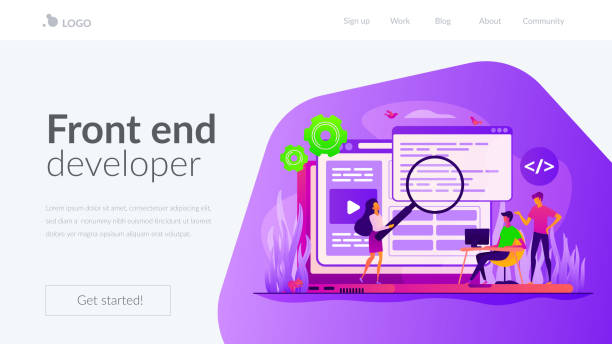Introduction to Responsive Web Design: Why is it Important?

In today’s digital world, where the variety of devices for accessing the internet is countless, responsive web design is no longer a luxury option but a vital necessity.
This approach means building a website that can adapt its appearance and functionality to the screen size, orientation, and platform of the user’s device.
Imagine a website that displays perfectly on a large desktop monitor, tablets of various sizes, and even the smallest mobile phone screen, providing a flawless user experience.
This #adaptability of websites not only helps improve #user_experience but also plays a key role in #SEO ranking and audience attraction.
In this explanatory section, we examine why #responsive_design is the backbone of a successful online presence in the current era and how it can transform your business.
In fact, the ultimate goal of responsive web design is to create a seamless and optimized user experience, regardless of the device the user employs to browse the web.
This principle is crucial in today’s competitive internet landscape, where users expect quick and easy access.
This tutorial is an introduction to the vast world of modern web design.
Do you dream of a thriving online store but don’t know where to start?
Rasaweb is your comprehensive e-commerce website design solution.
✅ Attractive and user-friendly design
✅ Increased sales and revenue⚡ Get a free consultation
The Importance of User Experience (UX) in Responsive Website Design

The importance of user experience (UX) in responsive web design is undeniable.
A properly designed responsive website ensures that users, regardless of the device they use, encounter a friendly and usable interface.
Imagine a user accessing a website designed for a desktop screen on their mobile phone; the need to zoom, horizontal scroll, and press small buttons would be a highly unpleasant and discouraging experience.
This is where responsive design comes to the rescue, ensuring that content, images, and navigation automatically adjust to the appropriate size and layout for each device.
This approach not only increases user satisfaction but also leads to longer user engagement on the website, reduced bounce rates, and increased interaction.
A mobile-compatible website allows users to easily find the information they need, complete forms, or make purchases.
This precise analysis shows that neglecting UX in responsive design can lead to customer loss and damage to brand reputation.
In the current era, where most web traffic comes from mobile devices, investing in responsive website design is an investment in the future of your business and guarantees an outstanding user experience for all audiences.
This is a key guide for any online business.
Key Technical Principles and Tools in Implementing Responsive Design

Responsive web design is built upon several key technical principles that every developer should master.
One of the most important principles is the use of Media Queries in CSS.
These commands allow the browser to apply different styles based on device characteristics (such as screen width, height, orientation, and resolution).
For example, one can specify that on smaller screens, fonts should be larger or columns should stack vertically instead of side-by-side.
Another principle is the use of Flexible Grids.
Instead of using fixed pixel units, relative units like percentages or ems are used for element widths.
This causes page elements to automatically scale with changes in screen size.
Additionally, Fluid Images, defined with the max-width: 100%; CSS property, ensure that images never overflow their container and are always displayed at the appropriate size.
Tools like CSS frameworks such as Bootstrap and Tailwind CSS have greatly simplified the implementation of responsive websites.
These frameworks accelerate development by providing pre-defined components and grid systems.
This technical information is vital for every developer.
| Feature | Responsive Design | Adaptive Design |
|---|---|---|
| Approach | A fluid layout that adapts to any screen size. | Multiple fixed layouts for specific screen sizes. |
| Primary Technique | Media Queries, Flexible Grids, Fluid Images. | Device detection, loading appropriate layout. |
| Flexibility | High, continuously scales. | Medium, limited to predefined breakpoints. |
| Implementation Complexity | Relatively complex initially, easier maintenance. | More complex for managing multiple layouts. |
| Performance | Can be heavy if not optimized. | Generally faster if layouts are optimized. |
The Impact of Responsive Design on SEO and Google Ranking

Responsive web design plays a vital role in a website’s SEO strategies.
Google and other search engines prioritize websites that offer a suitable user experience on mobile devices.
Since 2015, Google introduced its Mobile-Friendly Update algorithm, which penalizes non-responsive websites in mobile search results.
This trend was reinforced with the introduction of Mobile-First Indexing in 2018, meaning Google primarily considers the mobile version of your website for indexing and ranking.
The main advantage of responsive design for SEO is having only one URL for all devices.
This prevents the creation of duplicate content and related issues, which typically occur with separate mobile websites (e.g., m.example.com).
With a single URL, Google doesn’t need to crawl and index multiple versions of a page, which simplifies SEO management and centralizes SEO power.
Furthermore, reduced bounce rates and increased user dwell time, direct results of a good user experience on a responsive site, send strong positive signals to search engines.
This technical information and guidance help webmasters improve their position in search results.
Are your online sales not as expected? With Rasaweb, permanently solve the problem of low sales and poor user experience!
✅ Increase visitor-to-customer conversion rates
✅ Create an enjoyable user experience and boost customer trust
⚡ Act now for a free consultation!
Challenges and Important Tips in Implementing Responsive Web Design

Implementing responsive web design, despite its numerous advantages, is not without challenges.
One of the biggest concerns is website performance.
If images and other media files are not optimized for mobile devices, page loading can be time-consuming, which harms user experience and negatively impacts SEO.
Developers must ensure that images are loaded in appropriate sizes and utilize techniques such as Lazy Loading.
Another challenge is the complexity of content and design management for all screen sizes.
Ensuring that all elements display correctly and remain usable across all devices requires thorough and continuous testing.
Testing on multiple physical devices as well as browser emulators is essential.
The questionable content here might be whether simply having a responsive website is enough, or if attention should also be paid to the details of performance optimization and user experience? The answer is definitely the latter.
Furthermore, sometimes User Interface (UI) design for smaller devices requires difficult decisions, such as hiding certain elements or reprioritizing content.
This demands a specialized and strategic approach from the outset to prevent website bloat and maintain an optimal user experience across all dimensions.
The ‘Mobile-First’ Approach: The Foundation of Responsive Web Design

The ‘Mobile-First’ approach is a design and development philosophy at the heart of responsive web design and is increasingly recognized as an industry standard.
This approach means starting the design and development process from the smallest screens (like smartphones) and then scaling it up to larger screens (like tablets and desktops).
Unlike the traditional method, which starts with desktop and then attempts to adapt the design for mobile, the mobile-first approach ensures that the most important content and functionality are accessible and optimized in mobile versions as well.
This strategy not only helps optimize performance on mobile devices but also helps designers and developers focus on core content and essential functionalities.
With the limitations of mobile screen space, we are forced to identify and highlight what is truly important.
This approach also helps improve website loading speed on mobile devices, as only essential resources are loaded from the start, with additional resources for desktop being added later.
This is a key guidance for any responsive design project and leads to more efficient and user-friendly responsive web design.
The Future of Responsive Design and Emerging Trends

The web world is constantly evolving, and responsive web design is no exception.
Emerging trends and new technologies are continuously shaping new horizons for adaptable websites.
One such trend is the integration of Artificial Intelligence (AI) and Machine Learning into the design process.
AI-powered tools can automatically optimize designs based on user data and provide personalized user experiences.
Progressive Web Apps (PWAs) are another important trend that combines the benefits of websites and native applications.
PWAs are fast, reliable, and installable, offering an app-like user experience through the browser, even offline.
This technology is becoming increasingly important for responsive websites, as it bridges the gap between web and app experiences.
Also, the use of new CSS technologies such as Grid Layout and Flexbox allows designers to create more complex and flexible layouts with less and more optimized code.
These advancements further improve responsive web design and are good news for the future of the web.
| Trend | Description | Impact on Responsive Design |
|---|---|---|
| Progressive Web Apps (PWAs) | Combining the benefits of web and native applications. | Providing an app-like experience in the browser, offline capability. |
| AI in Design | Using artificial intelligence for optimization and personalization. | Automated designs and smarter user experience. |
| CSS Grid and Flexbox | Advanced CSS modules for layout. | Creating more complex and flexible layouts with ease. |
| Dark Mode | Providing a user interface with a dark background. | Increased eye comfort, OLED battery saving. |
Successful Examples of Responsive Web Design in Action

To better understand the power of responsive web design, a look at successful global examples can be inspiring.
Major companies such as Google, Apple, and even The New York Times have all designed their websites with a responsive approach.
These websites not only display well on every screen size but also provide a seamless and optimized user experience, which is one of the most important factors in their success.
For example, The New York Times website, with its responsive design approach, presents its news content in various formats, including desktop, tablet, and mobile, in the best possible way.
This website allows users to easily read articles, view images, and interact with content without needing to zoom or horizontal scroll.
This shows that even content-heavy sites can be optimized with responsive web design.
It is fascinating to see how large companies have achieved tremendous success with this approach and how responsive website design has become a gold standard in the web industry.
These examples demonstrate that investing in responsive design is not just a choice, but a necessity to stay relevant in today’s competitive market.
This analysis of successful websites further highlights the importance of this approach.
Are your online sales not as expected? With Rasaweb, permanently solve the problem of low sales and poor user experience!
✅ Increase visitor-to-customer conversion rates
✅ Create an enjoyable user experience and boost customer trust
⚡ Act now for a free consultation!
Testing and Optimizing Responsive Websites for Excellent Performance

After implementing responsive web design, the critical phase of testing and optimization begins.
Ensuring that your website functions correctly across all devices and browsers and provides an excellent user experience requires a systematic approach.
Utilizing browser developer tools, such as Chrome DevTools with its Device Mode, can be very useful for checking responsiveness across various screen dimensions.
Furthermore, online tools like Google PageSpeed Insights and GTmetrix are essential for performance optimization.
These tools evaluate your website’s loading speed and offer suggestions for improvement, including image compression, reducing CSS and JavaScript, and utilizing browser caching.
Optimizing images with modern formats like WebP and compressing them without losing quality is one of the most critical steps to increase loading speed on mobile devices.
Real-world testing on various physical devices (smartphones, tablets) is also very important to ensure that the user experience is optimal under actual conditions.
Additionally, checking accessibility for users with special needs is part of optimization.
This is a comprehensive tutorial and guide for maintaining the quality and performance of a responsive site.
Responsive Design and its Role in Digital Branding

Responsive web design goes beyond a technical matter; it is a vital element in modern digital branding.
In a world where users expect to access content anytime, anywhere, a website that is not properly responsively designed can quickly damage brand credibility and image.
Conversely, a website that performs optimally and flawlessly across all devices conveys an image of professionalism, innovation, and customer care.
Brands that invest in responsive implementation demonstrate that they value their customers’ user experience.
This leads to increased customer trust and loyalty.
A positive online experience, whether on a desktop, tablet, or mobile phone, makes users feel more comfortable and confident about the brand.
Ultimately, this means increased engagement, higher conversion rates, and consequently, sustainable business growth.
Another explanation on this topic is that in today’s digital marketing, the first impression of your brand often comes through your website, and if this impression is negative due to poor responsiveness, it will be difficult to recover.
This approach transforms responsive web design into a specialized tool for strengthening online presence.
Frequently Asked Questions
| Question | Answer |
|---|---|
| What is responsive web design? | It is a web design approach aimed at creating websites that can automatically adapt to the screen size and device of the user (computer, tablet, mobile) and provide the best user experience. |
| Why is responsive design important? | Its importance has increased due to the growing variety of devices people use to access the internet. This design improves user experience, increases search engine rankings (SEO), and reduces maintenance costs. |
| How is responsive design implemented? | By using CSS techniques such as Media Queries (which allow you to change styles based on device characteristics like screen width), Fluid Grids, and Flexible Images. |
| What are the key principles of responsive design? | The three main principles are: Fluid Grids (using relative units like percentages instead of pixels for widths), Flexible Images (adapting image sizes to available space), and Media Queries (applying different styles based on screen characteristics). |
| What are the benefits of having a responsive website? | Providing a unified user experience across all devices, improved SEO, increased user time on site, reduced bounce rate, easier site management and updates (there is only one codebase). |
And other services of Rasaweb Advertising Agency in the field of advertising
Smart Customer Journey Map: A novel service for increasing click-through rates through attractive UI design.
Smart Conversion Rate Optimization: A creative platform for improving campaign management with Google Ads management.
Smart Custom Software: A professional solution for customer acquisition focusing on SEO-driven content strategy.
Smart Digital Advertising: A fast and efficient solution for online growth focusing on custom programming.
Smart Link Building: A combination of creativity and technology for customer acquisition through custom programming.
And over a hundred other services in the field of internet advertising, advertising consulting, and organizational solutions
Internet Advertising | Advertising Strategy | Advertorials
References
Responsive Web Design Guide
What is Responsive Design?
Responsive Web Design Tutorial
Why is Responsive Web Design Important?
?With Rasaweb Afarin, your business shines at its peak! With our expertise in personal website design and a wide range of digital marketing services, we create a powerful and impactful online presence for you in the digital world.
📍 Tehran, Mirdamad Street, next to Bank Markazi, Kazeroon Southern Alley, Ramin Alley, No. 6



